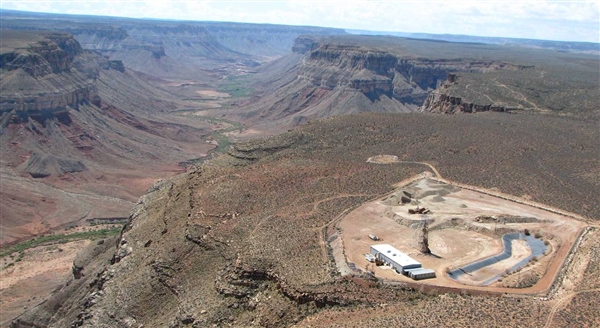
For most Americans, the words ‘uranium mining’, ‘nuclear testing’, and ‘radioactive waste’ is the stuff of a bad action movie: top-secret underground military facilities guarded by men in hazmat suits, so far out in the barren desert that the only impacts to civilization occur when the latest government experiment happens to escape and terrorize New York City. However, for the communities living in the Grand Canyon region, the uranium industry is a real and constant presence, with a tragic legacy of environmental health impacts that will continue to pose contamination threats to the region for at least 10,000 years. Some of these historical uranium impacts are located within the boundaries of Grand Canyon National Park—the Orphan Mine tramway, operated on the rim of the canyon until 1969, just steps from where buses now unload swarms of tourists wielding selfie-sticks.
The Colorado Plateau is the main source of domestic uranium in the United States, due to the natural occurrence of uranium concentrations formed by geologic processes. Warm, hot mineral rich water dissolves the limestone layer and forms a vertical column, which fills with rocks from the overlying units. Within this column, metals including Uraninite (UO2) precipitate out, concentrating this substance and making access for mining purposes easier. There are about 1300 of these columns, known as Breccia pipes, in the Grand Canyon region. These Brecchia pipes can be preferential pathways for groundwater, upon which the region is dependent for drinking water.
Despite a 20-year moratorium on mining claims signed in 2012 by the Department of the Interior, uranium mining, milling, and disposal activities that began before this moratorium continue to occur in the region. Natural uranium is mined from the source, milled, and enriched in order to increase its utility for both power production and for military weapons. Enrichment is the process by which neutrons are removed from natural uranium, forming U-235, a highly fissile product that can sustain fission from its own emission of neutrons (think mushroom clouds). After this process is completed, used radioactive fuel must be safely stored. The Grand Canyon region and its human and non-human inhabitants are exposed to the contamination risks of all three stages of the uranium life cycle: mining, milling, and disposal: from “cradle to grave”.
The Orphan Mine, which opened in the late 1800s, removed 800,000 tons of uranium from the bottom of the Grand Canyon before it closed in 1969. A 2009 USGS investigation showed elevated dissolved uranium concentrations at Orphan compared to the background rate. Perhaps just as impactful as the mining itself, the milling, or processing of uranium has lead to significant groundwater contamination at three sites, including the Moab, Tuba City, and Church Rock mills. At the Moab site, mine tailings were disposed in unlined pits until 1984, leading to elevated Ammonia concentrations in the CO river. The leftover 10.8 million tons of radioactive tailings are currently being moved, one dump truck at a time, to a new disposal site 30 miles away, at a taxpayer cost of $700 million dollars. At the Church Rock mill site, a 1979 failure in the structure that contains the mine tailings caused 1000 tons of radioactive waste and 93 gallons of tailings solution to be emptied into the Puerco River, cutting off access to clean water for 1700 people and releasing more radioactivity than the famous accident at Three-Mile Island.
In nearby Nevada, military test sites have detonated some 1000 nuclear weapons (mostly underground), leading to groundwater radioactivity that is five orders of magnitude higher than the background rate.
All of this mining, milling, and testing activity produces waste, radioactive waste, that will need to be stored long-term. Therefore, the U.S. government has been constructing a facility under Yucca Mountain in Nevada, which could serve as the final repository for 77,000 US high level radioactive waste.
The Yucca Mountain storage facility has a design life of 10,000 years, an amount of time which reflects both the expected half-life of this radioactive material, and is also just a nice, round number that the Department of Energy can get on board with. In agreeing on the design life of this facility, government officials were forced to ponder something they rarely, if ever, consider: how will our current actions affect the human race far into the future? Designing Yucca Mountain raised some fascinating questions, such as, what symbols should we use to warn humans 10,000 years in the future about our radioactive waste?
This line of thinking is reminiscent of the famous quote from Iriquois tribal law, "In every deliberation, we must consider the impact on the seventh generation.” How will our current decisions look to human society with 10,000 years of hindsight, assuming the human race has persisted? Or, in the increasingly realistic scenario that, in 10,000 years, aliens land on our barren, lifeless planet, what will they think? One thing is for sure—if the aliens land anywhere near the uranium storage facilities in the Grand Canyon region, we won’t look like a particularly intelligent life form.
